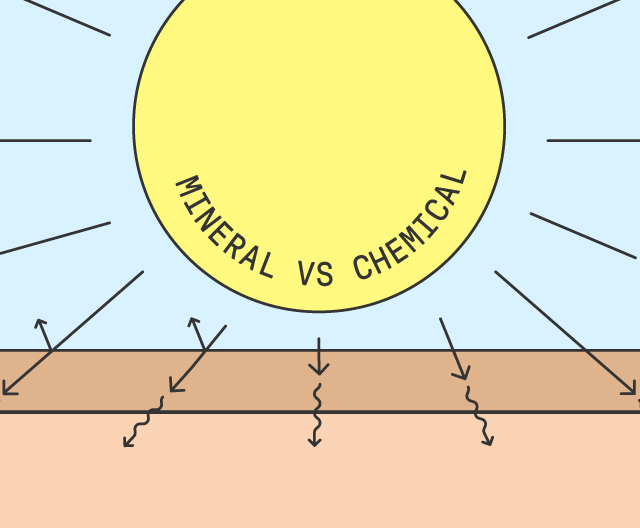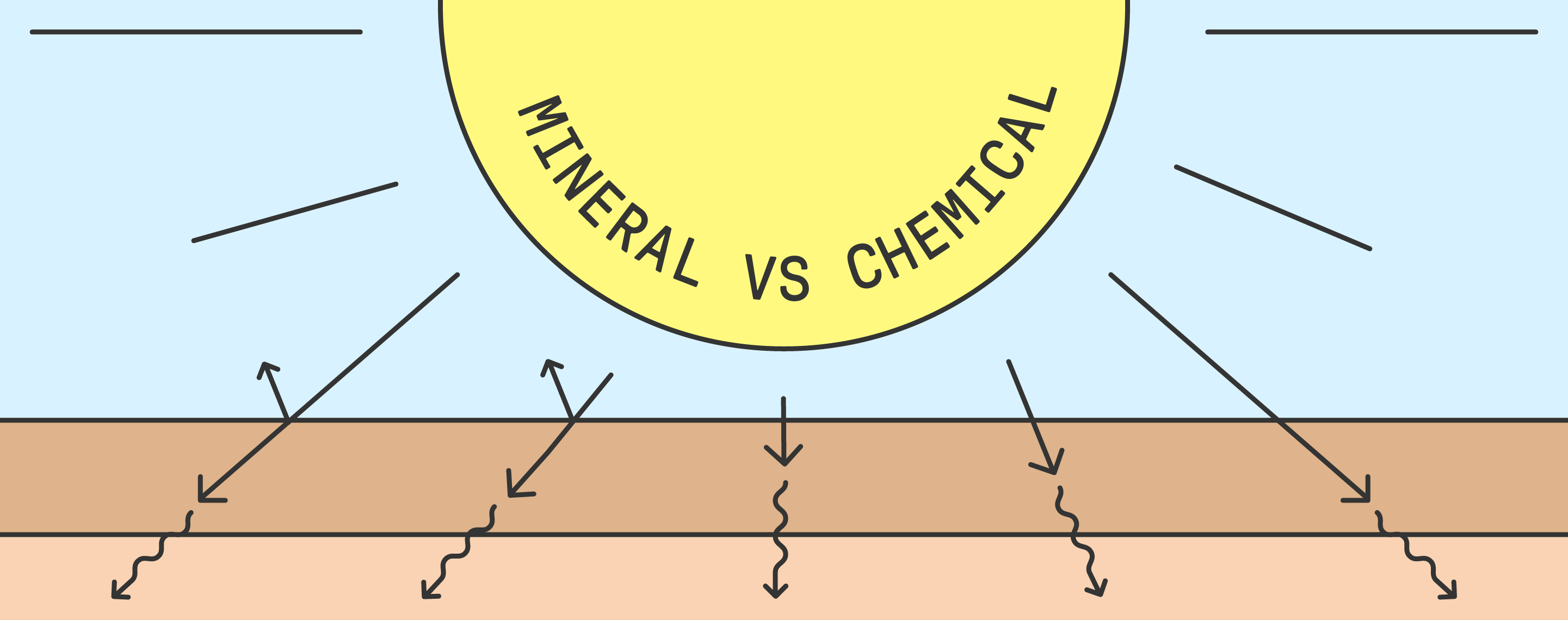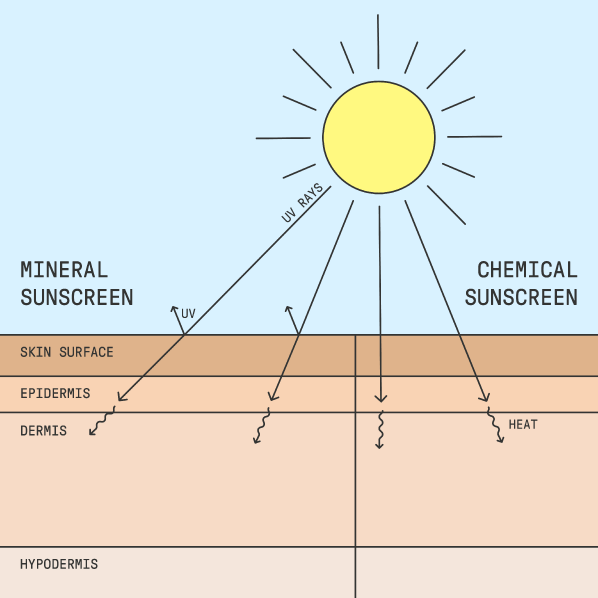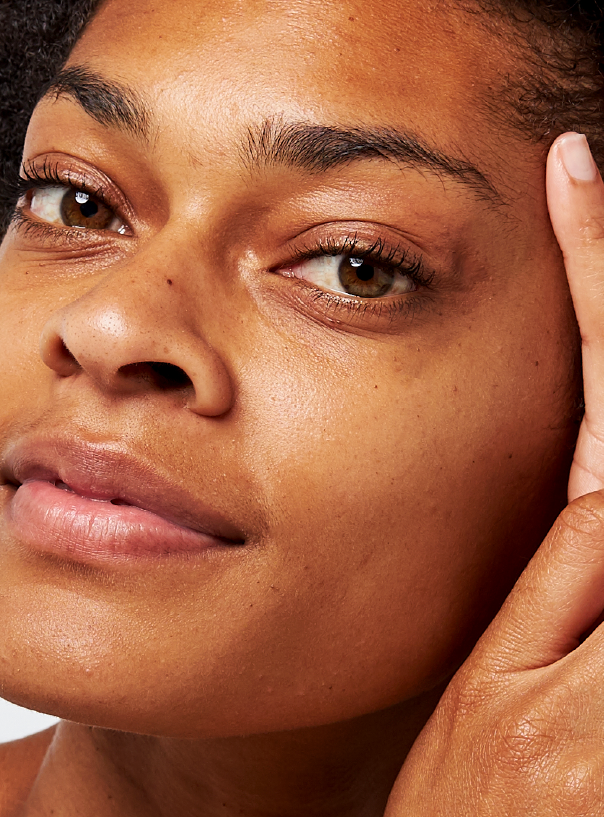Education
Mineral vs. Chemical Sunscreen


SHARE
Education
Mineral vs. Chemical Sunscreen
Medically reviewed by Aimee Paik, MD
Written by Annie Lam
Last updated 10/4/2024
Pretty much everyone is talking about sunscreen on Instagram and TikTok right now and for good reason. Applying your SPF is the most important step in your routine. It keeps your skin protected from UVA/UVB rays and reduces your risk of skin cancer. One of the biggest debates, however, is if chemical or mineral sunscreens are “better”. We’re sharing our derm-backed take on these sunscreen filters.
The Two Types of Sunscreen Filters
While most people know sunscreens as “chemical” and “mineral”, these are just common nicknames. Technically, there are two main types of sunscreen filters: organic (chemical) and inorganic (mineral). Organic (chemical) UV filters “are a group of carbon-containing compounds designed to absorb UV radiation.” Inorganic (mineral or physical) UV filters are a group of mineral oxides that are commonly referred to as mineral or physical filters. Now that we know the two types of sunscreen filters, let’s talk about the difference.


What is Chemical Sunscreen?
Chemical sunscreens use organic filters like octinoxate, octisalate, oxybenzone, avobenzone, octocrylene, and more. These filters work primarily by absorbing UV rays and converting them into heat. However, some organic filters like Tinosorb M also reflect a small percentage of UV rays, just like mineral sunscreens. Chemical sunscreens can get a bad reputation, but they’re completely safe and effective to use.
What is Mineral Sunscreen?
Mineral sunscreens use inorganic filters like zinc oxide and titanium dioxide. According to our medical director Dr. Paik, “Zinc oxide is the best sunscreen ingredient for preventing hyperpigmentation.” It also provides dependable broad-spectrum coverage. One common misconception about norganic filters is that they reflect all UV rays, when in reality, only about 5-10% of rays are reflected. The other 90-95% of rays are absorbed and converted into heat, just like organic filters.
Is one better than the other?
All sunscreen filters provide good protection against UVB rays (the main skin cancer causing rays), but not all filters provide dependable protection against longer-wavelength UVA rays that promote hyperpigmentation. Some of the chemical UVA filters break down quickly in real-world use whereas zinc oxide provides the most dependable true broad-spectrum coverage.
Mineral sunscreens with inorganic filters tend to be chalkier and can leave a white cast, whereas chemical ones with organic filters are generally more cosmetically elegant. Certain organic filters (like avobenzone) can be a bit more sensitizing on the skin, so some dermatologists recommend inorganic filters for more sensitive skin.
However, it’s important to address that it’s difficult for people with darker skin tones to find a mineral sunscreen that works for them because of the aforementioned white cast. Many brands say that inorganic (mineral) sunscreens are “better” but this leaves minimal options for darker skin tones. Chemical sunscreens are just as effective, safe for use, and tend to have little to no white cast. SPF options with organic (chemical) filters are a great option for darker skin tones.
In reality, it doesn’t really matter what type of sunscreen you use. What’s most important is that you’re applying at least SPF 30 every day, and are diligent with reapplying every 2 hours when you’re outdoors. So which sunscreen you decide to choose doesn’t really matter as long as you’re applying enough product. Most dermatologists recommend at least ⅓ - ½ a teaspoon for your face, neck, and ears.
The Dark Horse: Hybrid Sunscreens
A less talked about option is hybrid sunscreens, which use a combination of organic and inorganic filters. These sunscreens combine the benefits of mineral and chemical sunscreens. They tend to be better tolerated by sensitive skin while being more cosmetically elegant than sunscreens with purely inorganic filters. Hybrid sunscreens are a great option to try out for a more blendable sunscreen that may be more suitable for sensitive skin.
Overall, when it comes to the big “chemical vs mineral” sunscreen debate, one isn’t really better than the other. They each have their own set of benefits. At the end of the day, what matters most is finding sunscreen you love and are willing to apply every day. Our derms recommend looking for broad-spectrum protection of at least SPF 30. Regardless of which type of sunscreen you choose, don’t forget to #SlatherOn your SPF!
Like what you just read? Sign up for our email list to get the scoop on skincare science delivered straight to your inbox.

Deep Dives
A dermatologist shares his thoughts on the recent studies about benzoyl peroxide and benzene.
Read More
Education
What is milia?
What is milia? Today, we’re jumping into one type of bump that you may have heard about most commonly in infants — milia.
Read More
Education
Best moisturizer for acne-prone skin
If you have combination acne-prone skin, figuring out which moisturizer is best for your skin might be tough. In this guide, we break down the best moisturizer for combination, acne-prone skin.
Read More